
Laboratory glassware refers to a variety of equipment used in scientific work, and traditionally made of glass. Glass can be blown, bent, cut, molded, and formed into many sizes and shapes, and is therefore common in chemistry, biology, and analytical laboratories. Many laboratories have training programs to demonstrate how glassware is used and to alert first–time users to the safety hazards involved with using glassware.

A test tube, also known as a culture tube or sample tube, is a common piece of laboratory glassware consisting of a finger-like length of glass or clear plastic tubing, open at the top and closed at the bottom.
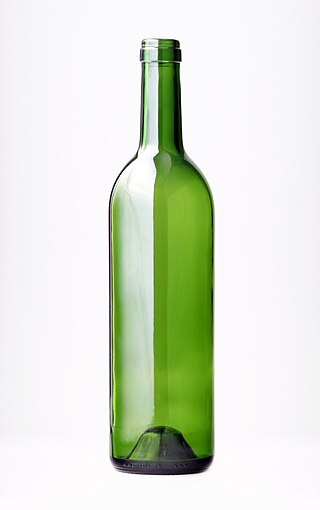
A bottle is a narrow-necked container made of an impermeable material in various shapes and sizes that stores and transports liquids. Its mouth, at the bottling line, can be sealed with an internal stopper, an external bottle cap, a closure, or induction sealing.

A carboy, also known as a demijohn or a lady jeanne, is a rigid container with a typical capacity of 4 to 60 litres. Carboys are primarily used for transporting liquids, often water or chemicals.

A bottle cap or bottle top is a closure for the top opening of a bottle. A cap is sometimes colorfully decorated with the logo of the brand of contents. Plastic caps are used for plastic bottles, while metal with plastic backing is used for glass; plastic caps are commonly made from polyethylene or polypropylene, while metal caps are usually either steel or aluminum. Plastic caps may have a pour spout. Flip-Top caps like Flapper closures provide controlled dispensing of dry products. Caps for plastic bottles are often made of a different type of plastic from the bottle.
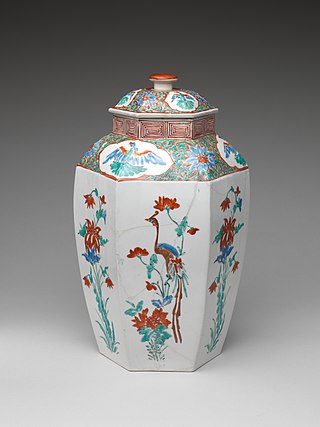
A jar is a rigid, cylindrical or slightly conical container, typically made of glass, ceramic, or plastic, with a wide mouth or opening that can be closed with a lid, screw cap, lug cap, cork stopper, roll-on cap, crimp-on cap, press-on cap, plastic shrink, heat sealed lidding film, an inner seal, a tamper-evident band, or other suitable means.
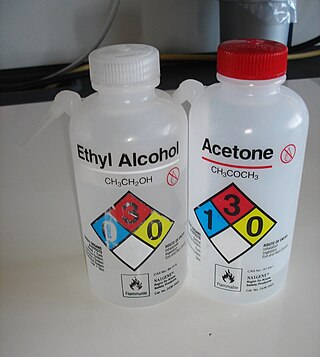
Nalgene is a brand of plastic products developed originally for laboratory use, including such items as jars, bottles, test tubes, and Petri dishes, that were shatterproof and lighter than glass. The properties of plastic products make them suitable for work with many substances in various temperature ranges.

A stopper or cork is a cylindrical or conical closure used to seal a container, such as a bottle, tube or barrel. Unlike a lid or bottle cap, which encloses a container from the outside without displacing the inner volume, a bung is partially or wholly inserted inside the container to act as a seal.
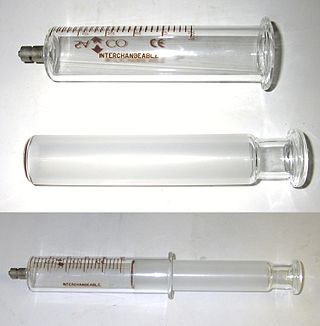
A gas syringe is a piece of laboratory glassware used to insert or withdraw a volume of a gas from a closed system, or to measure the volume of gas evolved from a chemical reaction. A gas syringe can also be used to measure and dispense liquids, especially where these liquids need to be kept free from air.

A closure is a device used to close or seal a container such as a bottle, jug, jar, tube, or can. A closure may be a cap, cover, lid, plug, liner, or the like. The part of the container to which the closure is applied is called the finish.
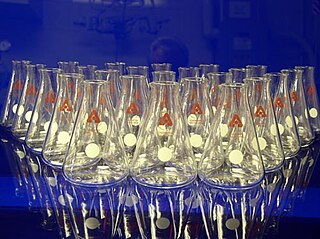
Laboratory flasks are vessels or containers that fall into the category of laboratory equipment known as glassware. In laboratory and other scientific settings, they are usually referred to simply as flasks. Flasks come in a number of shapes and a wide range of sizes, but a common distinguishing aspect in their shapes is a wider vessel "body" and one narrower tubular sections at the top called necks which have an opening at the top. Laboratory flask sizes are specified by the volume they can hold, typically in metric units such as milliliters or liters. Laboratory flasks have traditionally been made of glass, but can also be made of plastic.

Glass milk bottles are glass bottles used for milk. They are generally reusable and returnable - used mainly for doorstep delivery of fresh milk by milkmen as retail store sale is available in certain regions of the United Kingdom. Once customers have finished the milk, empty bottles are expected to be rinsed and left on the doorstep for collection, or rinsed bottles may be returned to a participating retail store. Bottle sizes vary depending on region but common sizes include: pint, quart, litre, etc.

A jug is a type of container commonly used to hold liquids. It has an opening, sometimes narrow, from which to pour or drink, and has a handle, and often a pouring lip. Jugs throughout history have been made of metal, and ceramic, or glass, and plastic is now common.
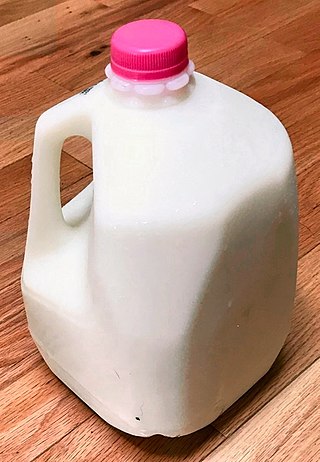
Plastic milk containers are plastic containers for storing, shipping and dispensing milk. Plastic bottles, sometimes called jugs, have largely replaced glass bottles for home consumption. Glass milk bottles have traditionally been reusable while light-weight plastic bottles are designed for single trips and plastic recycling.

A vial is a small glass or plastic vessel or bottle, often used to store medication as liquids, powders or capsules. They can also be used as scientific sample vessels; for instance, in autosampler devices in analytical chromatography. Vial-like glass containers date back to classical antiquity; modern vials are often made of plastics such as polypropylene. There are different types of vials such as a single dose vial and multi-dose vials often used for medications. The single dose vial is only used once whereas a multi-dose vial can be used more than once. The CDC sets specific guidelines on multi-dose vials.

An eye dropper, also called Pasteur pipette or simply dropper, is a device used to transfer small quantities of liquids. They are used in the laboratory and also to dispense small amounts of liquid medicines. A very common use was to dispense eye drops into the eye. The commonly recognized form is a glass tube tapered to a narrow point and fitted with a rubber bulb at the top, although many styles of both plastic and glass droppers exist. The combination of the pipette and rubber bulb has also been referred to as a teat pipette. The Pasteur pipette name is from the French scientist Louis Pasteur, who used a variant of them extensively during his research. In the past, there was no equipment to transfer a chemical solution without exposing it to the external environment. The hygiene and purity of chemical compounds is necessary for the expected result of each experiment. The eye dropper, both glass and plastic types, can be sterilized and plugged with a rubber bulb at the open end of the pipette preventing any contamination from the atmosphere. Generally, they are considered cheap enough to be disposable, however, so long as the glass point is not chipped, the eye dropper may be washed and reused indefinitely.

A plastic bottle is a bottle constructed from high-density or low density plastic. Plastic bottles are typically used to store liquids such as water, soft drinks, motor oil, cooking oil, medicine, shampoo, milk, and ink. The size ranges from very small bottles to large carboys. Consumer blow molded containers often have integral handles or are shaped to facilitate grasping.

A laboratory rubber stopper or a rubber bung or a rubber cork is mainly used in chemical laboratories in combination with flasks and test tube and also for fermentation in winery. Generally, in a laboratory, the sizes of rubber stoppers can be varied up to approximately 16 sizes and each of it is specific to certain type of container. As the rubber stopper is used in many experiments, some specific experiment requires a specific material. For example, the M35 Green neoprene stopper is for chemical resistance. For food fermentation, M18 white natural gum is preferred. For high temperature application, red or white silicone rubber stoppers should be used.

A water container, water canister or water can is a medium-sized portable container for transport, storage and use of water. Large plastic bottles are sometimes called "canisters". Water canisters can for example be used for drinking water, wastewater or showering. Water canisters are used for excursions, camping, boat trips, in cabins without tap water, or as a household drinking water reserve in case of emergency.



















